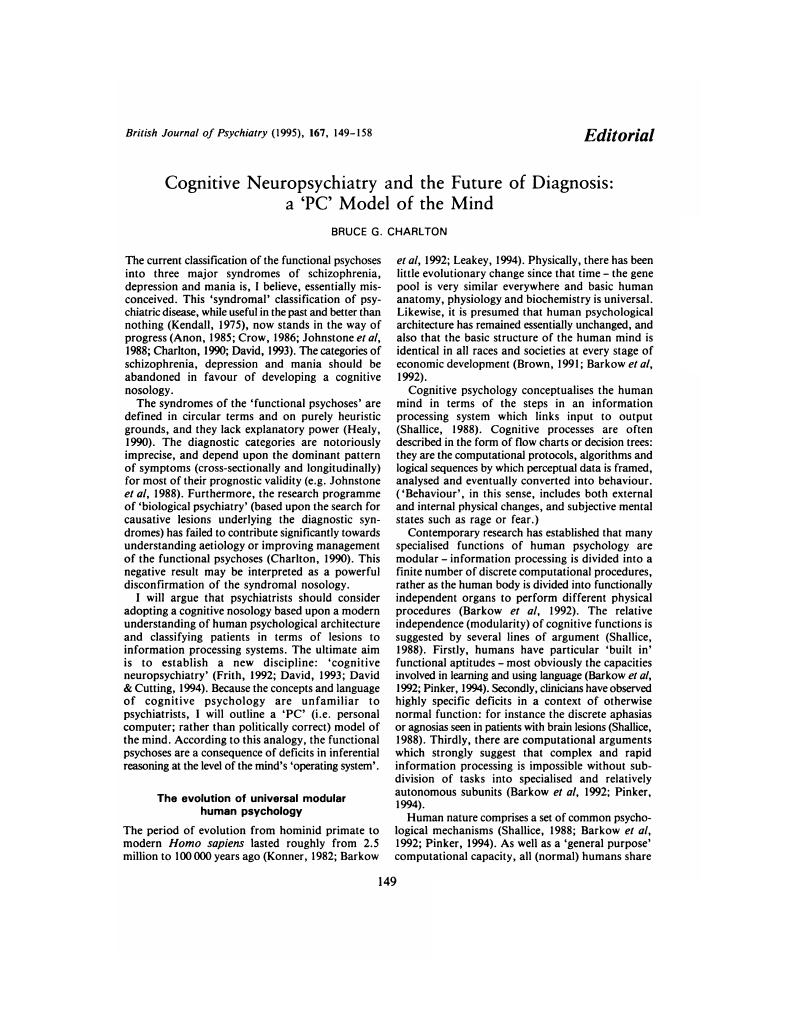Crossref Citations
This article has been cited by the following publications. This list is generated based on data provided by Crossref.
Hartman, D.
1995.
[No Title].
British Journal of Psychiatry,
Vol. 167,
Issue. 5,
p.
693.
Oyebode, F.
1995.
[No Title].
British Journal of Psychiatry,
Vol. 167,
Issue. 5,
p.
693.
Harrison, P. J.
and
Geddes, J.
1995.
A ‘PC’ model of the mind.
British Journal of Psychiatry,
Vol. 167,
Issue. 5,
p.
692.
Grant, Donald C.
and
Harari, Edwin
1996.
Diagnosis and Serious Mental Illness.
Australian & New Zealand Journal of Psychiatry,
Vol. 30,
Issue. 4,
p.
445.
Morton, John
1996.
Opinion: Reflections on Cognitive Neuropsychiatry.
Cognitive Neuropsychiatry,
Vol. 1,
Issue. 3,
p.
259.
Surtees, P. G.
Wainwright, N. W. J.
and
Gilks, W. R.
1996.
Diagnostic complexity and depression: time to allow for uncertainty.
Psychological Medicine,
Vol. 26,
Issue. 6,
p.
1105.
Charlton, Bruce G
1997.
A Syllabus for Evolutionary Medicine.
Journal of the Royal Society of Medicine,
Vol. 90,
Issue. 7,
p.
397.
Charlton, Bruce G.
1997.
The Inequity of Inequality.
Journal of Health Psychology,
Vol. 2,
Issue. 3,
p.
413.
Walston, Florence
David, Anthony S.
and
Charlton, Bruce G.
1998.
Sex Differences in the Content of Persecutory Delusions.
Evolution and Human Behavior,
Vol. 19,
Issue. 4,
p.
257.
MD, Bruce G. Charlton
and
BMedSci, Florence Walston
1998.
Individual case studies in clinical research.
Journal of Evaluation in Clinical Practice,
Vol. 4,
Issue. 2,
p.
147.
Charlton, B.G.
2000.
The malaise theory of depression: major depressive disorder is sickness behavior and antidepressants are analgesic.
Medical Hypotheses,
Vol. 54,
Issue. 1,
p.
126.
Lawrence, A. D.
and
Sahakian, B. J.
2001.
Clinical Trials in Neurology.
p.
171.
Halligan, Peter W
and
David, Anthony S
2001.
Cognitive neuropsychiatry: towards a scientific psychopathology.
Nature Reviews Neuroscience,
Vol. 2,
Issue. 3,
p.
209.
Charlton, Bruce G.
2007.
Scientific discovery, peak experiences and the Col-oh-nell Flastratus! phenomenon.
Medical Hypotheses,
Vol. 69,
Issue. 3,
p.
475.
Mellsop, Graham
and
Kumar, Shailesh
2007.
Classification and Diagnosis in Psychiatry: The Emperor's Clothes Provide Illusory Court Comfort.
Psychiatry, Psychology and Law,
Vol. 14,
Issue. 1,
p.
95.
Raju, Venkateshwarla Rama
2023.
Quantifiable objective psychopathology via cognitive neuropsychiatry: A hybrid-study Part I.
IP Indian Journal of Neurosciences,
Vol. 9,
Issue. 1,
p.
8.




eLetters
No eLetters have been published for this article.